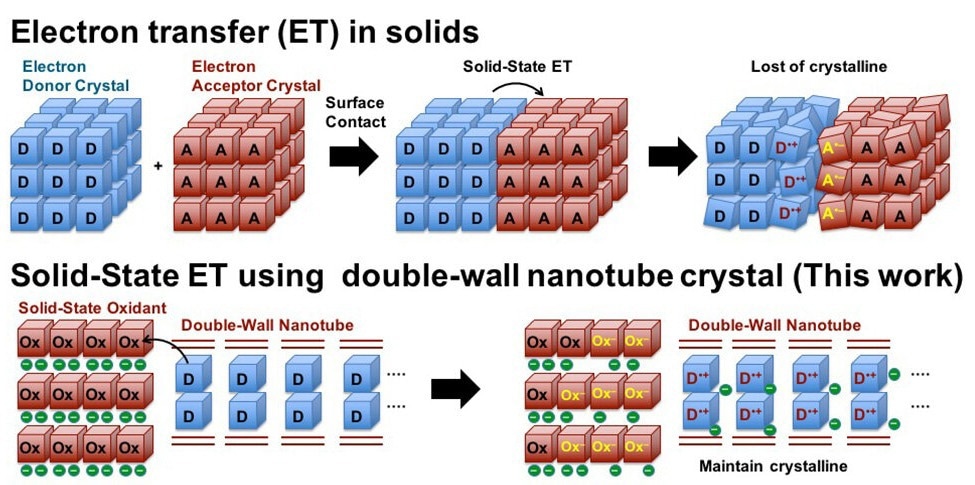In a recent study, scientists from Tokyo University created zinc-based double-walled crystalline nanotubes using a brand-new supramolecular crystallization technique that entails oxidation-based crystallization. The study has been published in the journal Nature Communications.
 Direct observation of electrons transfer in double-walled crystalline nanotube. The novel double-walled nanotube structure developed in this study can absorb electron donor molecules and maintain its crystalline nature during electron transfer, thus facilitating electron transfer observation. Image Credit: Junpei Yuasa from Tokyo University of Science
Direct observation of electrons transfer in double-walled crystalline nanotube. The novel double-walled nanotube structure developed in this study can absorb electron donor molecules and maintain its crystalline nature during electron transfer, thus facilitating electron transfer observation. Image Credit: Junpei Yuasa from Tokyo University of Science
Electron transfer (ET) is the process of transferring an electron from one atom or molecule to another. ET is crucial to electrochemical processes and has various uses. Nanoscale ET, which includes the transmission of electrons in the range of 1-100 nanometers in solids, is critical to creating multifunctional materials. However, the mechanism is not yet well understood.
Nanotubes, nanomaterials with distinct cylindrical nanostructures, provide ET features that can be produced through electrons and holes (empty spaces left by electrons) in the nanotubes, making them an ideal candidate for researching nanoscale ET. Although carbon-based nanotubes exhibit remarkable ET features, they are extremely challenging to regulate in terms of form and size because of the severe conditions necessary for their synthesis, such as high temperatures.
Although it occasionally yields crystalline-form nanotubes, bottom-up production of non-covalent nanotubes is a practical method for creating well-defined, adjustable nanotubes. Instead of the strong covalent bonds seen in carbon nanotubes, non-covalent nanotubes are generated by the intrinsic attractive interactions or non-covalent interactions between atoms.
Their crystalline structure can be destroyed and their non-covalent interactions broken by electron and hole injections, which they cannot withstand.
In a recent study, Dr Daiji Ogata, Mr. Shota Koide, Mr. Hiroyuki Kishi, and other researchers from the Tokyo University of Science Department of Applied Chemistry, under the direction of Professor Junpei Yuasa, employed a unique method to directly observe solid-state ET.
We have developed crystalline nanotubes with a special double-walled structure. By incorporating electron donor molecules into the pores of these crystalline nanotubes through a solid-state oxidation reaction, we succeeded in directly observing the electron transfer reaction in the solid using X-ray crystal structure analysis.
Junpei Yuasa, Professor, Department of Applied Chemistry, Tokyo University
The scientists created zinc-based double-walled crystalline nanotubes using a brand-new supramolecular crystallization technique that entails oxidation-based crystallization. The crystal’s strong and flexible structure, with large windows in the walls of the nanotubes, allows it to maintain its crystalline form even when exposed to ET oxidation processes. Furthermore, the crystal can take in electron-donor molecules because of its structure.
Utilizing ferrocene and tetrathiafulvalene as electron donor molecules, the researchers allowed the molecules to enter the nanotube crystals through their windows. This makes it possible for solid-state ET oxidation processes to extract electrons from the absorbed electron donors, which causes holes to accumulate in the donors inside the nanotube.
Thanks to the crystals’ resilience, the researchers were able to use X-Ray crystal structure analysis to directly monitor this ET oxidation process, which provided important new insights.
This unique method is extremely useful for direct observation of ET in solid nanomaterials.
Emphasizing the study’s possible applications Prof. Yuasa stated, “Understanding ET can lead to the development of novel functional materials, which in turn can lead to the design of more efficient semiconductors, transistors, and other electronic devices. Optoelectronic devices, such as solar cells, rely heavily on ET. Hence, direct observation of ET can help improve these devices' performance. Additionally, this approach can lead to advancements in energy storage, nanotechnology, and materials science research.”
This study is a remarkable illustration of direct solid-state ET observation, which can be expanded to view ET and associated phenomena in different nanomaterials.
Journal Reference:
Ogata, D., et al. (2024) Direct observation of electron transfer in solids through X-ray crystallography. Nature Communications. doi:10.1038/s41467-024-48599-1